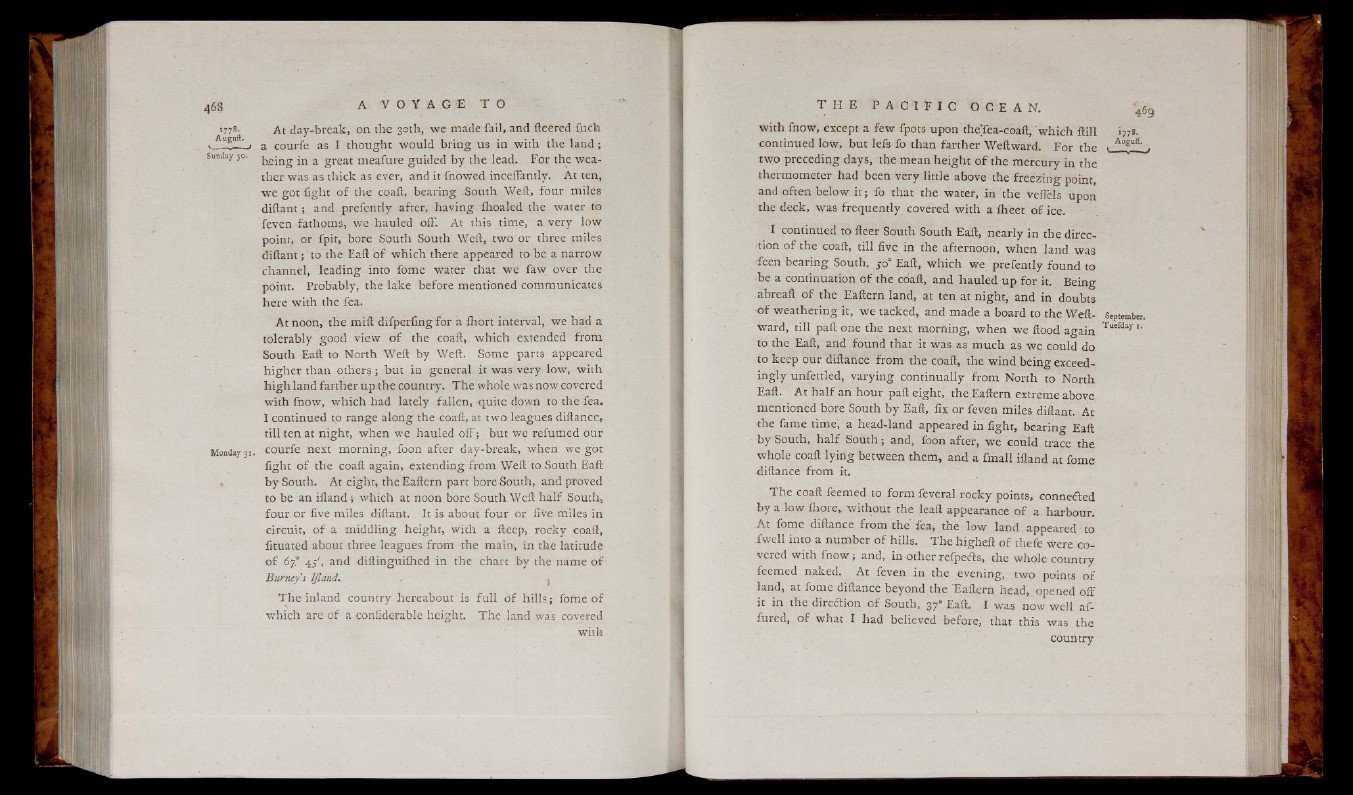
1778. At day-break, on the 30th, w e made fail, and fleered fuch
. Ang^ ' a courfe as I thought would bring us in with the la n d ;
Sunday 30. ;n a g reat meafure guided by the lead. For the weather
was as thick as ever, and it fnowed inceffantly. At ten,
w e got fight o f the coaft, bearing .South Weft, four miles
diftant j and prefently after, having ihoaled the water to
feven fathoms, we hauled off. At this time, a very low
point, or fpit, bore South South Weft, two or three miles
diftant; to the Eaft o f which there appeared to be a narrow
channel, leading into fome water that w e faw over the
point. Probably, the lake before mentioned communicates
here with the fea.
A t noon, the mift difperfing for a ihort interval, we had a
tolerably good view o f the coaft, w hich extended from
South Eaft to North Weft by Weft. Some parts appeared
h igh e r than o th e r s ; but in general it was very low, w ith
h ig h land farther up the country. The whole was now covered
with fnow, w hich had lately fallen, quite down to the fea.
I continued to range a long the coaft, at two leagues diftance,
till ten at night, when we hauled o f f ; but we refumed our
Monday 31. courfe next morning, foon after day-break, when we got
fight o f the coaft again, extending from Weft to South Eaft
b y South. At eight, the Eaftern part bore South, and proved
to be an ifland ; which at noon bore South Weft h a lf South,
fou r or five miles diftant. It is about fou r or five miles in
circuit, o f a middling height, with a fteep, rocky coaft,
fituated about three leagues from the main, in the latitude
o f 67° 4s', and diftinguiihed in the chart by the name o f
Burney s IJIand.
T h e inland country hereabout is fu ll o f hills ; fome o f
which are o f a confiderable height. T he land was covered
with
with fnow, except a few fpots upon theTea-coaft, w hich ftill 1 7 7 8 .
continued low, but lefs fo than farther Weftward. For the . Ausult-
two preceding days, the mean height o f the mercury in the
thermometer had been very little above the fre e z in g point,
and often below i t ; fo that the water, in the veffels upon
the deck, was frequently covered with a flieet o f ice.
I continued to fteer South South Eaft, nearly in the direction
o f the coaft, till five in the afternoon, when land was
feen bearing South, yo° Eaft, w hich we prefently found to
be a continuation o f the coaft, and hauled up for it. Being
abreaft o f the Eaftern land, at ten at night, and in doubts
o f weathering it, we tacked, and made a board to the Weft- September,
ward, till paft one the next morning, when we flood again T“efdajr'•
to the Eaft, and found that it was as much as we could do
to keep our diftance from the coaft, the wind being exceedin
g ly unfettled, va ryin g continually from North to North
Eaft. At h a lf an hour paft eight, the Eaftern extreme above
mentioned bore South b y Eaft, fix or feven miles diftant. At
th e fame time, a head-land appeared in fight, bearing Eaft
b y South, h a lf S o u th ; and, foon after, w e could trace the
whole coaft ly in g between them, and a fmall ifland at fome
diftance from it.
T h e coaft feemed to form feveral rocky points, connected
b y a low ihore, without the leaft appearance o f a harbour.
At fome diftance from the fea, the low land appeared to
fwe ll into a number o f hills. The higheft o f thefe were covered
with fnow ; and, in other refpefts, the whole country
feemed naked. At feven in the evening, two points o f
land, at fome diftance beyond the Eaftern head, opened o ff
it in the dire&ion o f South, 37* Eaft. I was now well af-
fured, o f what I had believed before, that this was the
country